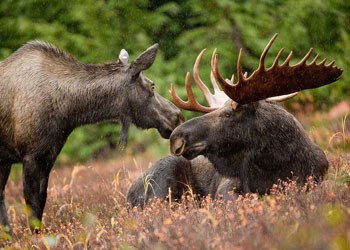Watch out! There's a moose on the loose!
It's happened in Yorkton and it could happen again.
Your day is starting like any other. The sun is out. The birds are singing. It's going to be a great day. Then you pour your morning coffee and look out the window and see a massive four-legged creature meandering down the street or nibbling on your neighbour's prized flower garden.
It's a moose!
As the moose population has increased in southern Saskatchewan, so too have encounters with these large creatures across the province, including incidents within the cities of Regina and Saskatoon. Periodically, conservation officers are called out to yards, back alleys, local parks and school yards, to investigate reports of various wildlife wandering into the city.
When dealing with any wildlife situations, public safety is always paramount.
In some instances, moose find their own way out of the city. In others, the situation is handled quickly and quietly with not a lot of fuss or fanfare - almost like a covert operation. And that is exactly how Ministry of Environment conservation officers like Mark Dietz prefer it.
"A quiet situation is really helpful," saysDietz, who is based in the Regina field office. "There have been a few occasions where the moose are pushed out of an area by individuals and run to the point of exhaustion. It is really hard on the animal and makes it tougher to tranquilize because the animal is full of adrenaline."
Keeping the animal calm is much better for all involved, including the moose.
"If it is a quiet and calm encounter, you dart it, the animal walks around and then goes to sleep," Dietz adds. "Those scenarios usually work out pretty well."
In the Regina area, the sedated animal is then loaded onto a flat-deck tow truck and moved out of the city, usually to an area near Condie Reservoir, just northwest of the city.
This is common in the spring, when the young animals wander in to various communities and get themselves into trouble. They are generally last year's calves that have spent the year with their mother; when she has a new calf, the mother kicks out the yearlings.
Moose are able to survive in the prairie habitat because there is a nutritious food source growing in the form of canola, alfalfa, and peas. In other areas, moose will supplement their diet with willow and aspen.
Moose also travel seasonally to forage in new areas within their home range.
And when they wander down a street or are found in a backyard, it can cause quite a bit of excitement for local residents.
The challenge for officers is that from the time the call comes in to when they arrive on scene, the moose could be blocks away - they have a habit of wandering into backyards and lying down during the middle of the day.
But sometimes they get really lucky.
Last year, one young moose wandered into the staff parking compound at Regina fire station that was fenced. The staff simply closed the gate and it settled right down.
"The moose could have gone over the fence if it wanted to, but it found a nice quiet place to rest. We had easy access and we were able to get a dart into it. It went to sleep between a couple of vehicles and we were able to get a tow truck in there and hauled it out of the city."
Generally, two or three officers will respond to the calls, but they also receive assistance from local police and other agencies.
Similar scenarios play out in Saskatoon as well.
In mid-June, a young bull moose wandered into Saskatoon and conservation officers were able to tranquilize, tag and fit the animal with a radio transmitting collar.
The University of Saskatchewan is studying moose ecology and the research will help develop strategies to better manage southern moose populations.
This project will also determine key habitats for farmland moose, document their movements, and identify key environmental factors affecting where and when moose cross roads and highways.
Regina conservation officers receive close to 20 calls per year about moose in the city or nuisance moose in farmyards. A busy year in Regina would be darting six animals.
In Saskatoon, the ministry tranquilized its first moose in 2006, and since then the totals have ranged from zero to six incidents per year. Last year, the total jumped to 13 animals having to be removed.
"We certainly get more calls about moose in the city than we tranquilize, because sometimes the moose aren't found when we attend the scene. Other times they find their own way out of the city or we help guide them out," says conservation officer Kerry Wrishko, who is based in Saskatoon. "In the vast majority of instances, things go according to plan."
As the younger animals find suitable habitat, the issue of moose in the city tends to subside. However, the officers are always ready to respond. During the fall rut, bull moose will sometimes wander into the cities looking for a mate and the officers will once again be called to deal with the situation.
"In smaller communities and small cities, officers also respond to these calls. But more often than not, the animal leaves on its own accord or is successfully guided out of town," Wrishko adds.
"Fortunately, traffic congestion is not a problem in these communities, unlike Circle Drive in Saskatoon or Ring Road in Regina."
Current moose populations are listed as stable to slightly lower than 2013 across the province, particularly in agricultural areas of Saskatchewan where liberal hunting quotas currently exist.
Moose licences and season structures have been targeted towards areas having higher moose populations and a greater potential for public conflict and public safety.




